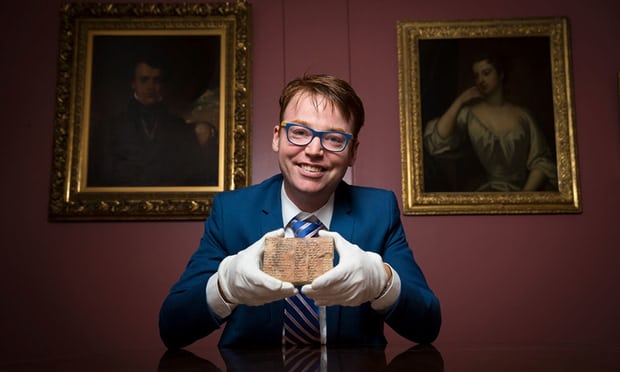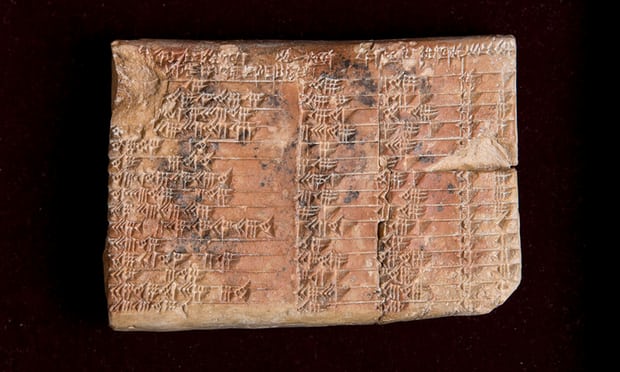At least 1,000 years before the Greek mathematician Pythagoras looked at a right angled triangle and worked out that the square of the longest side is always equal to the sum of the squares of the other two, an unknown Babylonian genius took a clay tablet and a reed pen and marked out not just the same theorem, but a series of trigonometry tables which scientists claim are more accurate than any available today.
The 3,700-year-old broken clay tablet survives in the collections of Columbia University, and scientists now believe they have cracked its secrets.
The team from the University of New South Wales in Sydney believe that the four columns and 15 rows of cuneiform – wedge shaped indentations made in the wet clay – represent the world’s oldest and most accurate working trigonometric table, a working tool which could have been used in surveying, and in calculating how to construct temples, palaces and pyramids.
The fabled sophistication of Babylonian architecture and engineering is borne out by excavation. The Hanging Gardens of Babylon, believed by some archaeologists to have been a planted step pyramid with a complex artificial watering system, was written of by Greek historians as one of the seven wonders of the ancient world.

Daniel Mansfield, of the university’s school of mathematics and statistics, described the tablet which may unlock some of their methods as “a fascinating mathematical work that demonstrates undoubted genius” – with potential modern application because the base 60 used in calculations by the Babylonians permitted many more accurate fractions than the contemporary base 10.
Mathematicians have been arguing for most of a century about the interpretation of the tablet known as Plimpton 322, ever since the New York publisher George Plimpton bequeathed it to Columbia University in the 1930s as part of a major collection. He bought it from Edgar Banks, a diplomat, antiquities dealer and flamboyant amateur archaeologist said to have inspired the character of Indiana Jones – his feats included climbing Mount Ararat in an unsuccessful attempt to find Noah’s Ark – who had excavated it in southern Iraq in the early 20th century.
Mansfield, who has published his research with his colleague Norman Wildberger in the journal Historia Mathematica, says that while mathematicians understood for decades that the tablet demonstrates that the theorem long predated Pythagoras, there had been no agreement about the intended use of the tablet.
“The huge mystery, until now, was its purpose – why the ancient scribes carried out the complex task of generating and sorting the numbers on the tablet. Our research reveals that Plimpton 322 describes the shapes of right-angle triangles using a novel kind of trigonometry based on ratios, not angles and circles. It is a fascinating mathematical work that demonstrates undoubted genius.
“The tablet not only contains the world’s oldest trigonometric table; it is also the only completely accurate trigonometric table, because of the very different Babylonian approach to arithmetic and geometry. This means it has great relevance for our modern world. Babylonian mathematics may have been out of fashion for more than 3,000 years, but it has possible practical applications in surveying, computer graphics and education. This is a rare example of the ancient world teaching us something new.”
The tablet also long predates the Greek astronomer Hipparchus, traditionally regarded as the father of trigonometry.
Wildberger said: “Plimpton 322 predates Hipparchus by more than 1,000 years. It opens up new possibilities not just for modern mathematics research, but also for mathematics education. With Plimpton 322 we see a simpler, more accurate trigonometry that has clear advantages over our own.”
He and Mansfield believe there is more to learn of Babylonian maths, still buried in untranslated or unstudied tablets.
“A treasure trove of Babylonian tablets exists, but only a fraction of them have been studied yet. The mathematical world is only waking up to the fact that this ancient but very sophisticated mathematical culture has much to teach us.”
They suggest that the mathematics of Plimpton 322 indicate that it originally had six columns and 38 rows. They believe it was a working tool, not – as some have suggested – simply a teaching aid for checking calculations. “Plimpton 322 was a powerful tool that could have been used for surveying fields or making architectural calculations to build palaces, temples or step pyramids,” Mansfield said.
As far back as 1945 the Austrian mathematician Otto Neugebauer and his associate Abraham Sachs were the first to note that Plimpton 322 has 15 pairs of numbers forming parts of Pythagorean triples: three whole numbers a, b and c such that a squared plus b squared equal c squared. The integers 3, 4 and 5 are a well-known example of a Pythagorean triple, but the values on Plimpton 322 are often considerably larger with, for example, the first row referencing the triple 119, 120 and 169.
More: Mathematical secrets of ancient tablet unlocked after nearly a century of study
























